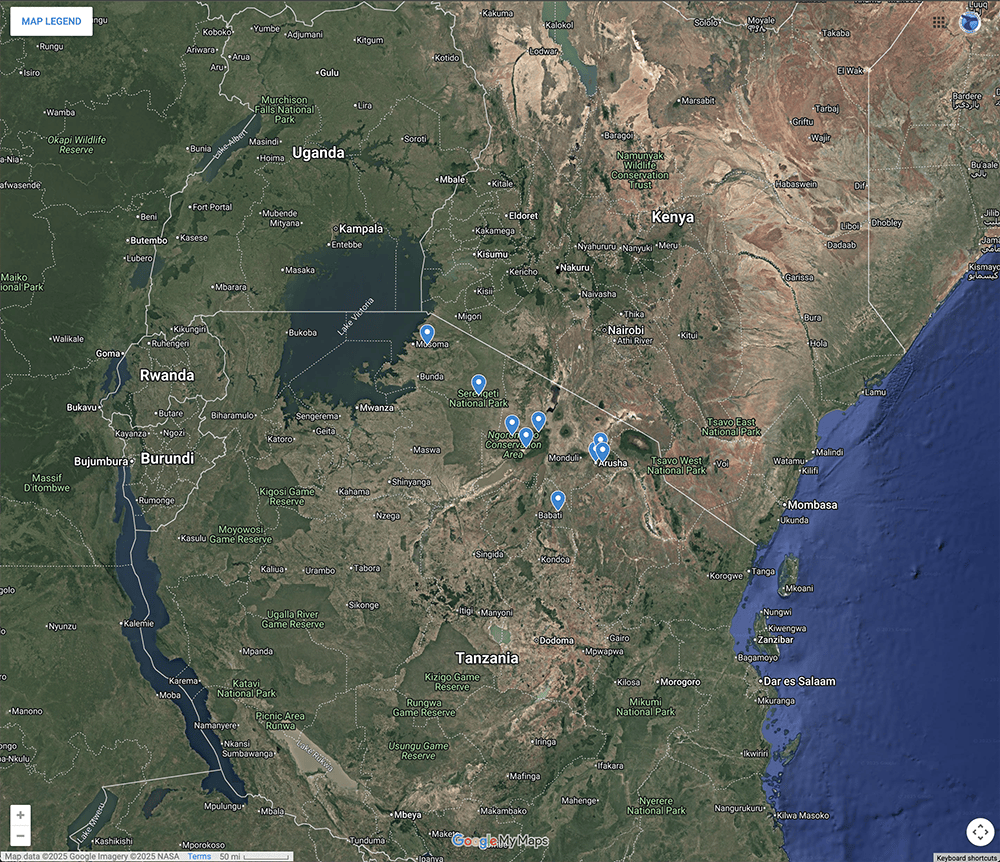The Great Migration of the Serengeti
Tanzania
July 16 to August 1, 2025
 Private Trip Available
Private Trip Available Safari Overview
Experience the Great Migration in the Serengeti, one of the most breathtaking wildlife spectacles on Earth. Witness thousands of wildebeest and zebras navigating predator-filled plains and braving the dramatic Mara River crossings, an iconic scene from nature documentaries. Explore the biodiversity of Ngorongoro Crater, a thriving ecosystem teeming with lions, elephants, and rhinos, and discover the diverse landscapes of Tarangire National Park, home to massive elephant herds and ancient baobabs. This ultimate African safari is designed to maximize wildlife encounters, with expert guides strategically positioning you for the best chance to witness a river crossing—an ephemeral, heart-pounding event that defines the magic of the Serengeti.
WHY CHOOSE THIS EXPEDITION?
- Great Migration Action: Witness wildebeest crossings at the Mara River, an iconic wildlife phenomenon.
- Prime Predator Viewing: Observe lions, leopards, and cheetahs hunting on the Serengeti plains.
- Exclusive Ngorongoro Exploration: Discover a UNESCO-listed crater teeming with elephants, rhinos, and hippos.
- Tarangire’s Elephant Kingdom: Experience up-close encounters with massive elephant herds beneath ancient baobabs.
- Expert-Led Adventure: Gain insights from seasoned safari guides with decades of experience in Tanzania.
⭐⭐⭐⭐⭐ “From pick-up to drop-off, it was a very well organized trip. Augustine and his team, were professional, knowledgeable and highly attentive to our needs. Augustine and the two other guides on our trip, David and Billdad, were super experienced, accomodating and tremendously knowledgeable. We were given more than ample time on safari drives to maximize our chances of seeing wildlife. I also appreciated the quality and unique location of our accommodations.” – Alan Robinson |
SEE WHAT AWAITS YOU
TRIP MAP
ENHANCE YOUR TRIP
- Continue your journey on our Zanzibar Extension from August 1 to 5.
NOTABLE EXPERIENCES
Itinerary Updated: March 2025

FAQ Print Trip Safari Options
| Date | Description | Lodge | Meals |
|---|---|---|---|
| Jul 16-17 | Travel to Tanzania. Depart for Arusha, Tanzania. | ||
| Jul 18 | Arrival in Arusha. Transfer to a scenic lodge for relaxation. | Serena Lodge, Arusha | |
| Jul 19-20 | Tarangire National Park Safari. Explore the park’s vast elephant herds and diverse predators. Enjoy a thrilling night safari. | Tarangire Safari Lodge, Tarangire National Park | B, L, D |
| Jul 21-23 | Ngorongoro Crater & Empakaai Hike. Discover an ecosystem teeming with wildlife, including rhinos and hippos. Hike to Empakaai Crater for breathtaking views. | Ngorongoro Lion’s Paw Lodge, Ngorongoro Crater Highlands | B, L, D |
| Jul 24 | Serengeti Exploration. Journey to Serengeti’s vast plains, known for leopards, hippo pools, and Maasai Kopjes. | Acacia Bliss Camp, Serengeti National Park. | B, L, D |
| Jul 25-27 | Great Migration & Mara River Crossings. Witness dramatic wildebeest migrations across crocodile-infested waters. | Mara River Camp, Serengeti National Park. | B, L, D |
| Jul 28-29 | Big Cat Safari in Serengeti. Track lions, cheetahs, and leopards in prime predator territory. | Sametu Tented Camp, Serengeti National Park | B, L, D |
| Jul 30 | Oldupai Gorge & Crater Highlands. Visit the famous paleoanthropological site and relax in the scenic highlands. | Ngorongoro Farm House, Crater Highlands | B, L |
| Jul 31 | Return to Arusha & Departure. Stop at the Cultural Heritage Center, enjoy a farewell meal, and prepare for departure or join our Zanzibar Extension. | Kia Lodge, Arusha (dayroom) | |
| Arrive Home. End of safari adventure. |
Our Trip Leaders
David Mshana
David has been a popular safari guide for over 25 years. He has an uncanny ability to spot leopards and other wildlife even while driving with consummate skill. His flexibility, kindness, and charm complement his spotting talents, and he is adept at getting the vehicle into position for the best possible wildlife photos. David has earned certificates in Tour Guiding and Leadership, and he is passionate about continuing to learn and grow as a guide. When not guiding, he takes care of his farm and family on the slopes of Mt. Meru.
Augustine Mwangotya
Augustine, founder and owner of our local safari operator, studied at Tanzania’s College of Wildlife Management and served with the Tanzania Wildlife Department, developing an invaluable set of connections and knowledge. He received his Master’s in Conservation Biology and Ecotourism from Prescott College in Arizona. Augustine’s warmth and humor, intimate knowledge of animal behavior, friendships with indigenous people, and command of logistical details have given him a well-deserved reputation in the safari field.
Emanuel Lema
Emanuel grew up at the base of Mt. Kilimanjaro, where his observations of guides taking visitors up the mountain inspired him to pursue a career in ecotourism. He exudes charisma and positive energy, and he shares his encyclopedic knowledge of birds and mammals with grace and humility. His birding skills, including recognition of vocalizations, are top-notch. He has over 17 years of experience guiding wildlife, natural history, and birding tours throughout Tanzania and is delighted to again be working for Cheesemans’.
Detailed Itinerary
A glimpse into our journey
Arrive in Arusha
Jul 18
Arrive at Kilimanjaro International Airport where our local agent will transfer you from the airport to the hotel.
Tarangire National Park
Jul 19-20
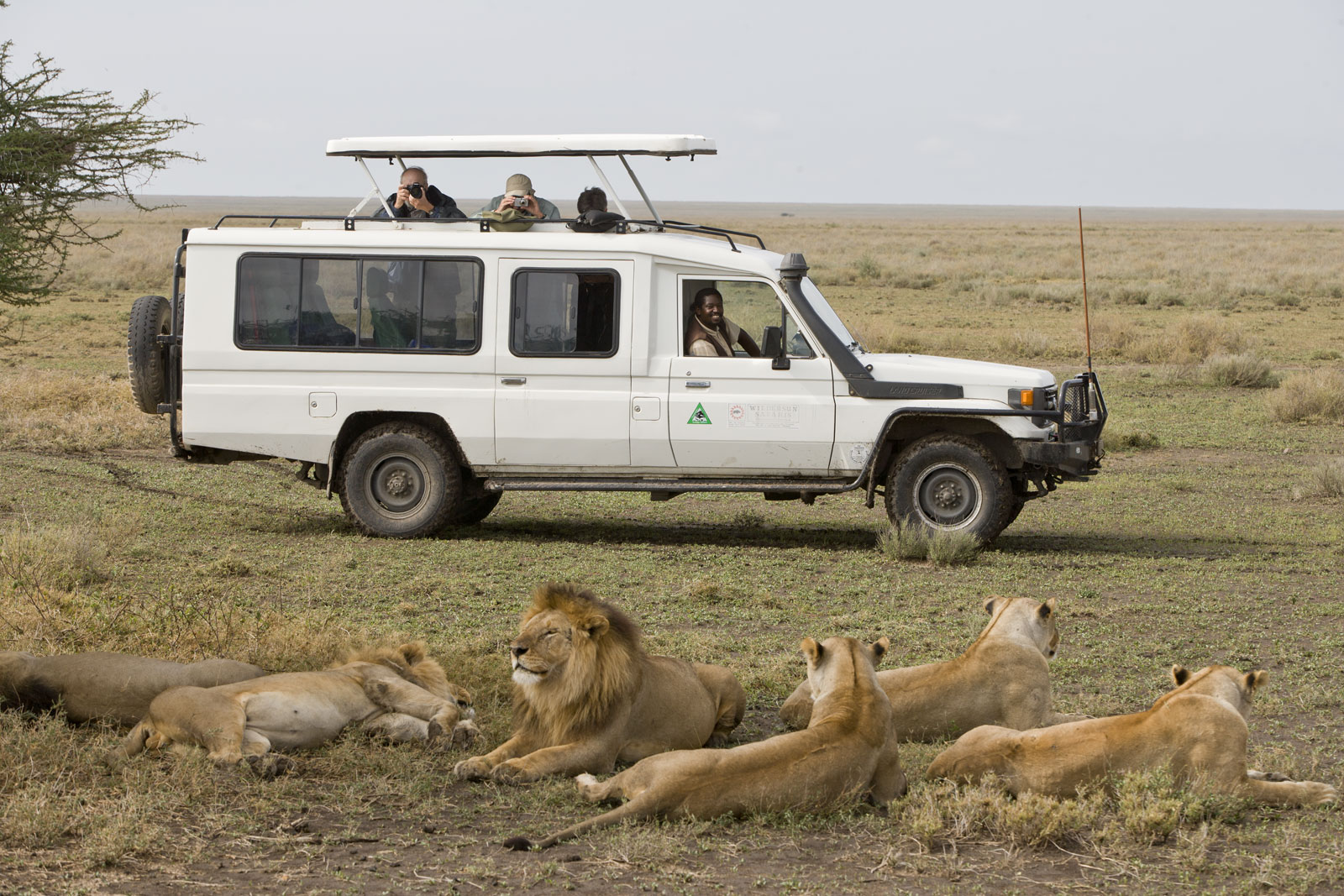
© Cheesemans' Ecology Safaris
This morning, you will drive to Tarangire National Park. With more than 1000 square miles, it is the third largest park Tanzania. You will see a wide variety of wildlife including elephants, impala, zebra wildebeest, oryx, and greater and lesser kudu. These, in turn, attract the predators: lion, leopard, cheetah, and hyena. You will also encounter small critters such as mongooses, hyraxes, squirrels, and incredible birds. The diverse landscape has open plains, stands of magnificent baobab trees, riverine forest, acacia parkland, scrub-woodlands, and wetlands. In the evening, you will go on a night game drive. Viewing nocturnal animals such as leopards, hyenas, porcupines, genets, civets, and bush babies are possible on a standard night game drive if you have good fortune. You even have chances of seeing African wild cats, serval cats, and many other nocturnal animals.
Ngorongoro Crater Highlands
Jul 21-23
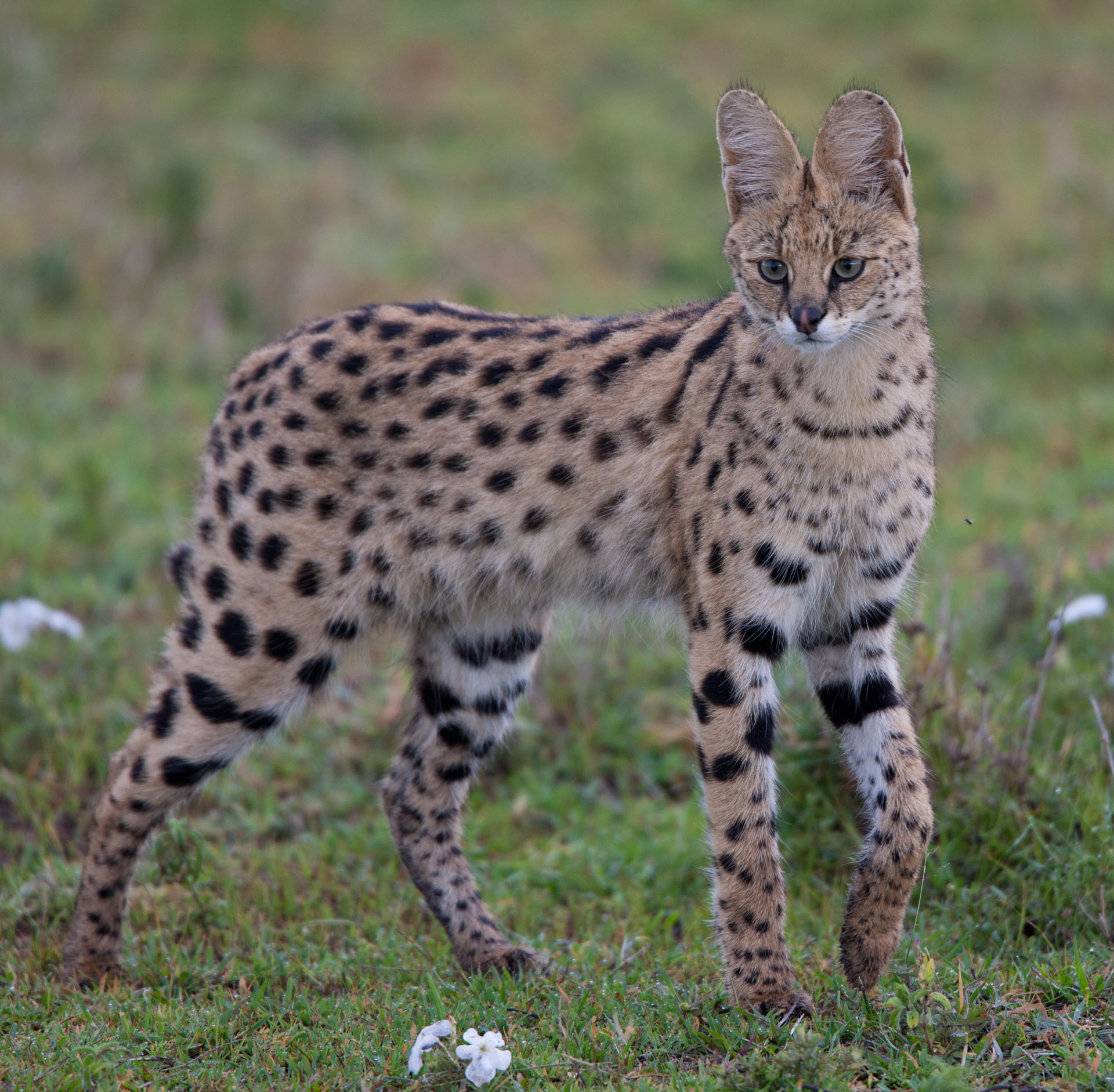
After a final exciting morning game drive at Tarangire, you will head west climbing the steep rift valley escarpment into the rich farmlands of the Ngorongoro Highlands. At the entrance gate to Ngorongoro Conservation Area, you will pass into lush forests as you ascend to the crater rim for our first view of the incredible landscape below. Brace yourself for a trip back into the Pleistocene! For the next two days, you’ll explore one of the world’s largest calderas, 10 to 11km in diameter and 2,500ft deep. Ngorongoro Crater is a World Heritage Site, truly one of the most-productive wildlife-viewing areas on the planet. This diverse ecosystem of forests, swamps, grasslands, and lakes supports lions, servals, hyenas, three kinds of jackal, baboons, monkeys, zebras, hippos, and thousands of antelopes, including the massive eland. Because poaching is not a problem here, rare black rhinos and elephants with enormous tusks thrive. It’s also a birding hotspot. You’ll have plenty of time to carefully observe animal behavior and get some wonderful photos of the animals that are habituated to vehicles and thus ignore you. You will early morning drive through open highlands where Maasai live in this bioregion conservation area eventually reaching the beautiful Empakaai Crater where you will be able to descend on foot to this jewel-like lake on a rare, special opportunity to walk relatively safe in wild Africa (we will have a guard and will certainly watch out for buffalo). You can take your time observing biodiversity along this area.
Serengeti National Park
Jul 24
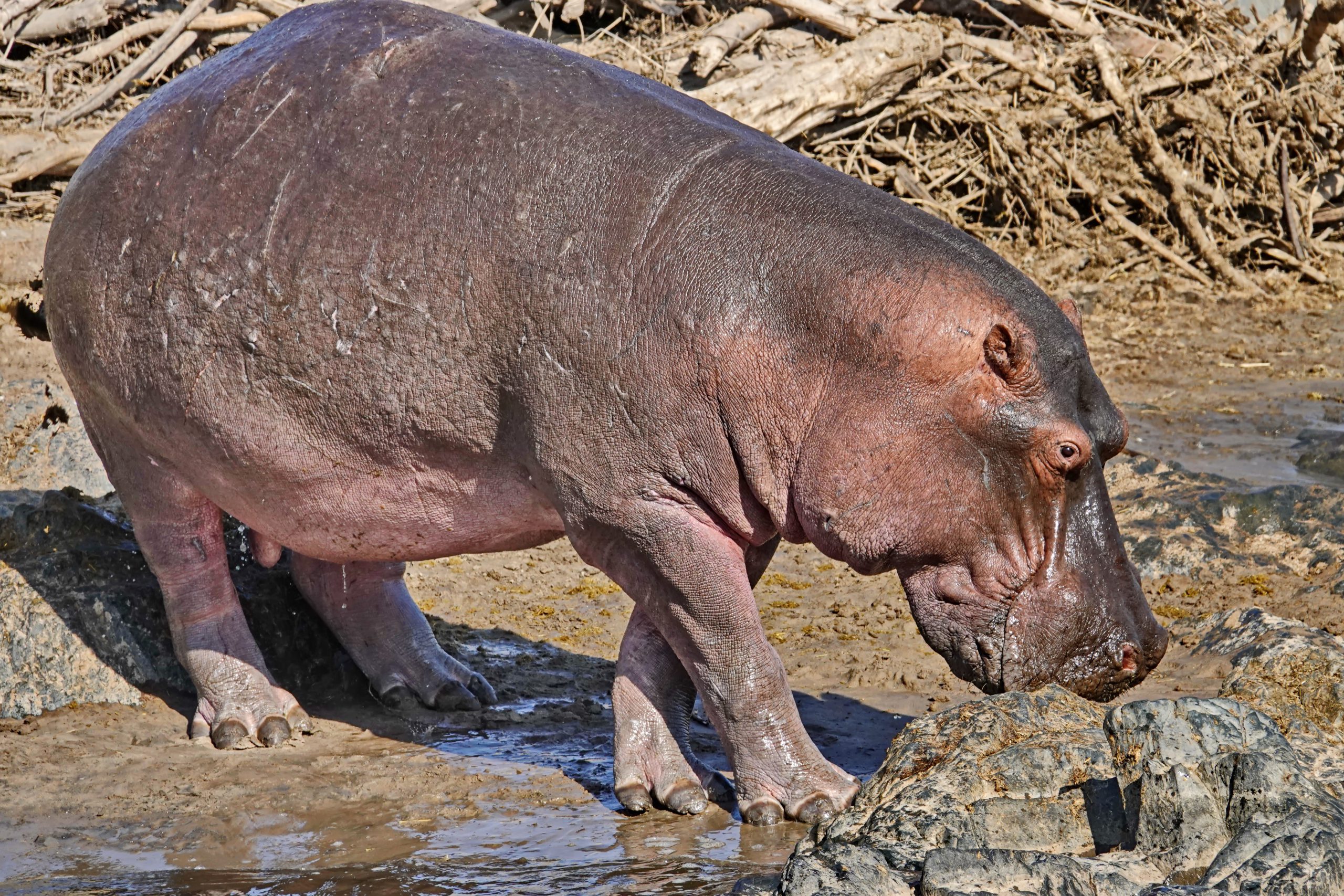
You’ll have six full days in the fabled Serengeti, one of the most prolific and important wildlife areas in the world. With its vast rolling plains, dramatic outcrops of Precambrian rocks (kopjes), flat-topped acacias, crocodile and hippo-inhabited rivers lined with riverine gallery forests, and huge herds of animals, the Serengeti is the ultimate in “wild Africa.” Birding here is special also; for example, there are more than 50 species of diurnal birds of prey ranging from tiny pygmy falcons to tall and stately secretary birds in this ecosystem. You will be astonished not only with the diversity of birds you will see but also by how easy it is to see them. Many—like the sunbirds, bee-eaters, rollers, hoopoes, starlings, kingfishers, barbets, bishops, and cordon bleus are stunningly beautiful. You are not simply trying to amass high species lists but also to take time to observe behavior and to soak in the beauty of the avian diversity. Patience can also yield wonderful photographic rewards. You’ll spend your first night in the Serengeti at the lovely Acacia Bliss Camp in an area noted for leopards, hippo pools, and the Maasai Kopjes.
More Serengeti National Park
Jul 25-27
You will continue your immersive Serengeti experience by proceeding north for three nights at Mara River Camp, which should be close to the heart of the migration, and you will venture to some areas of extraordinary beauty where large predators thrive. With good luck, you will see the herds undertaking the treacherous crossing of the Mara River. Instinct compels thousands of wildebeest to make this fateful journey seeking fertile grasslands. The famous “Great Migration” of wildebeest, zebra, and other grazing herbivores is one of the last mass movements of animals still taking place on earth. There is a lot of history here—both human and animal—and Augustine will enrich and inform your safari experience by providing the big picture to complement the fascinating details that you will witness directly.
Even More Serengeti
Jul 28-29

You’ll depart from Mara River Camp with a picnic lunch to spend another two full days in the Serengeti National Park heading to the central Serengeti. You will visit areas where conditions are right for the best wildlife action, especially looking for cheetah hunting and leopards that climb the yellow-barked acacia trees along the Seronera River. You'll drive along the marshy areas where lions like to lie in wait for the great variety of mammals and water birds that come in to drink. Most of the ungulates, including Giraffes, come to the marshy areas, rivers, and springs where they can find good water supplies. Lions have learned where to have the best chance to ambush. You'll spend two nights in a great location at Sametu Tented Camp in the mid-east Serengeti. The hours here will pass like minutes, and you will want to stay for a week just in this one vast landscape of kopjes arising out of the earth like cathedrals.
Oldupai Gorge and Crater Highlands
Jul 30
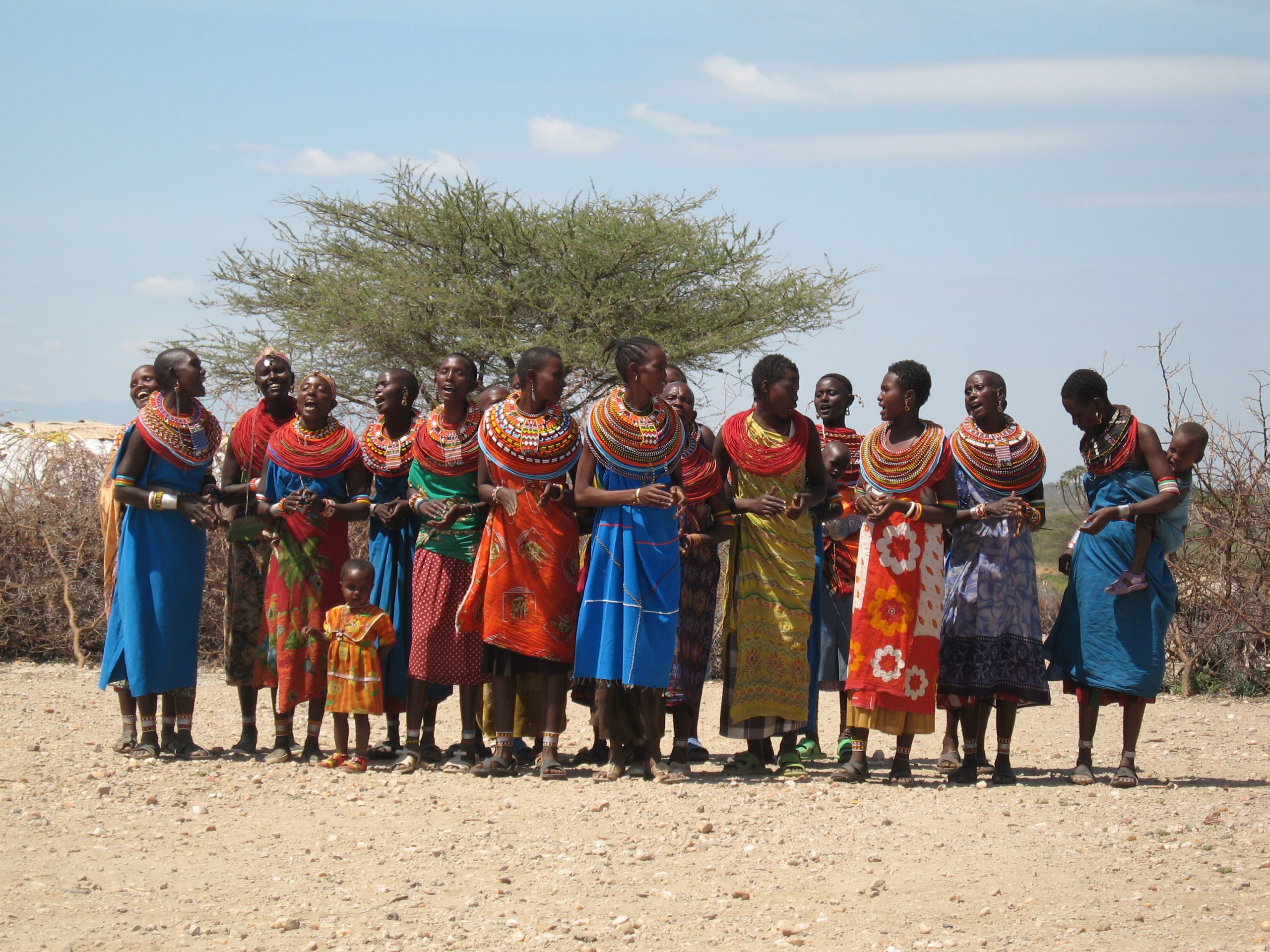
After your final breakfast in the Serengeti, you’ll drive across the plains ascending again into the highlands of the Ngorongoro Conservation Area, a World Heritage Site dedicated to the peaceful union of pastoralism, conservation of natural resources, and responsible tourism. You will stop to visit Oldupai (or Olduvai) Gorge, world renowned for the discoveries of early hominids made by archaeologists Mary and Louis Leakey. You will visit the wonderful museum there and, if time permits, explore the gorge where the discoveries were made. For many people, a visit to Oldupai is a pilgrimage to one of the world’s greatest archeological sites, a place where you can connect with our distant ancestors. You may also visit a Maasai Village. Thereafter, you will drive out of the park to relax at the Ngorongoro Farmhouse, whose lovely gardens provide scrumptious produce for this oasis and for some of the remote tented camps. On this night, you will share highlights of the safari as you prepare tomorrow to return to Arusha.
Back to Arusha and homeward or join our Zanzibar Extension
Jul 31
Today, you drive back to Arusha for a visit to the Cultural Heritage Center (wonderful wildlife art gallery and excellent shopping, including for precious Tanzanite jewelry), a scrumptious buffet lunch, and some time to rest and prepare for your trip home that evening. Day rooms at KIA Lodge. Guests on the Zanzibar Extension will spend the night at the KIA Lodge.
Arrive Home
- Cost & Payments
- Included
- Not Included
- FAQ
- Climate
- Fitness Level
- Accommodations
- Transportation
- Flights
 Conservation
Conservation- Conditions
Cost & Payments
Costs (in US$)
| Type | Cost Per Person |
|---|---|
| Trip Cost, double occupancy | $15,185 |
| Single Supplement | $2,533 |
Costs are per person, double occupancy, not including airfare, singles extra. See Included and Not Included sections for more details.
If you are a single traveler, we will try to find a roommate for you, but if we cannot pair you with a roommate, we may charge you a single supplement.
Payment Schedule
| Payment | Due Date | Amount Per Person |
|---|---|---|
| Deposit | Due now to reserve your space | $3,000 |
| Final Payment | February 1, 2025 | Remaining balance |
Payments are due based on the schedule above. All reservations require a deposit to confirm reservation of your space.
Cancellations
Until the Final Payment due date, deposits are refundable except for a cancellation fee of $150 per person, which can be applied toward another trip if reserved within six months of the cancelled trip’s departure date. Cancellations are non-transferrable. No refunds are given after the Final Payment due date.
Included
- Carbon offsets for the duration of this trip.
- All leaders, transport, park entry fees, landing fees, and permits for all activities unless described as optional.
- Accommodations – double occupancy for the nights of July 18 through July 30 and a dayroom on July 31.
- Meals from breakfast on July 19 through lunch on July 31.
- Transfers from the Kilimanjaro International Airport to Arusha Serena, regardless of arrival day, and from Kia Lodge to the Kilimanjaro International Airport via complimentary hotel airport shuttle, regardless of departure day.
- Trip Planning Materials – information about entry requirements, flights, packing, gratuities, etc.
- Short-term AMREF Flying Doctor emergency evacuation insurance. This does not include hospital or treatment costs.
Not Included
- Carbon offsets for your flights to/from this trip.
- All airfare, airport and departure taxes, and excess baggage fees. Round-trip airfare is approximately $1500 to $1800 between the US and Kilimanjaro International Airport, depending on origin.
- Passport and visa fees.
- COVID tests.
- Gratuities – tipping is always discretionary. However, we suggest budgeting $455 per participant ($35 per participant per day for 13 days with our local guides). You can give your gratuities to Augustine upon arrival to distribute throughout the trip.
- Optional trip cancellation insurance.
- Items of a personal nature such as laundry, telephone calls, medical costs or hospitalization, room service, alcoholic and other beverages, items not on the regular menu, etc. If you have special dietary needs, please indicate them on your Traveler Form.
Climate
July is dry season in Tanzania. Rain is unusual but possible. The highs are typically around 83°F, and the lows are generally about 56°F.
Fitness Level
You must be able to get in and out of a Land Cruiser. Most days consist of early mornings, game drives on bumpy roads, and long hours in nature that require good energy levels. Most walking is optional and around lodge grounds between game drives. The 3-mile round-trip hike at Empakaai Crater is optional; you can still enjoy the scenic drive and can stay at the rim with a staff member while others hike if you choose. Please contact us if you have any health concerns that may make this trip challenging.
Flights
Detailed logistical information is included in the Trip Planning Materials we will send you.
Flights you book
- Arrive at Kilimanjaro International Airport (JRO) near Arusha, Tanzania, by 11:59pm July 18.
- Depart from Kilimanjaro International Airport (JRO) after 5:00pm July 31. If you are continuing on our Zanzibar Extension, see the Flights section in its itinerary for departure information.
FAQ
Which safari is right for me if I want to travel to Africa?
If this is your first African safari, we suggest taking our Tanzania to experience the quintessential African safari. The grassy Serengeti Plains of Tanzania spread unbelievably from horizon to horizon and are often covered with migrating herds seeking fresh grass while predators pursue them.
Our Botswana and Zambia safari as well as our Zimbabwe safari provide you with a unique immersion into wild Africa that gives you an intimate 24/7 connection. On these trips, you find more animals suited to this dry watery environment such as hippos, elephants, and antelopes. It is possible to see the “big five” (African lion, African elephant, cape buffalo, African leopard, and rhinoceros) in all three countries.
What is the “Great Migration?”
The Great Serengeti Migration is the continuous movement of vast herds of western white-bearded wildebeest, common zebra, and Serengeti Thomson’s gazelle. Throughout the year the herds move in a circular, clockwise pattern around the Serengeti, heading northward or southward, seeking new green grass. It is the world’s largest terrestrial mammal migration! Even where the migration isn’t present, there are resident carnivores and buffalo, giraffe, topi, kongoni (Coke’s hartebeest), impala, eland, and Grant’s gazelle.
Which safari is best to see the “Great Migration?”
The exact timing of the migration is dependent on the seasonal rainfall that freshens the grass consumed by ungulates. Throughout the year the herds move in a circular pattern around the Serengeti, heading northward or southward, seeking new green grass. In January/February, wildlife is concentrated in the southern Serengeti short grass plains of Tanzania. In July/August, the famous Mara River crossings of wildebeest and zebra occur in the northern Serengeti ecosystem right on the border of Tanzania and Kenya. While the herbivores migrate through the Serengeti, they pass through the territories of many predators, such as lions, cheetahs, leopards, and hyenas.
How much time do I spend in nature?
You will spend maximum time in nature! To allow more time for observing relative to driving, you may be out all day with picnic lunches. If our activities are close enough to camp, you may return for lunch and a short break before heading out on a late-afternoon safari. Be prepared for long days.
Can I walk around to see the wildlife?
For safety reasons, you are not permitted to leave the vehicles on safari drives, although you can walk around the lodge grounds. The three-mile round-trip hike at Empakaai Crater is optional; you can still enjoy the scenic drive and can stay at the rim with a staff member while others hike if you choose.
What is Cheesemans’ background in East Africa tourism?
Cheesemans’ has been leading safaris in Tanzania and Kenya since 1978 and has had long, close relationships with our driver-guides. Not only do you have experts on wildlife behavior, but you also get a unique family-like experience from spending time with Augustine, David, and Emanuel.
Accommodations
You stay in top-notch lodges/camps with private baths near the parks/reserves and wildlife.
Motion Sickness
Transportation
You travel in pop-top Land Cruisers with shaded roof covers that provide 360° viewing and excellent photography opportunities. With only four participants in each seven-passenger vehicle, you’ll have more space for your gear and changing vantage points. Be prepared to experience bumpy, unpaved roads, and although our vehicles are comfortable, you will be jostled around.
Conservation
Our company ethos has always regarded conservation as inseparable from responsible tourism. We struggle with the dilemma that traveling worldwide expends climate-changing carbon. However, we wholeheartedly believe that traveling with us will cultivate your passion for conserving our beautiful world while stimulating each destination’s local economy. We encourage you to explore the various ways in which Cheesemans’ operates within this context:
- Ecotourism and Conservation for Tanzania
- Cheesemans’ Trips are Carbon Neutral.
- Offsetting your Travel to/from our Trip: We ask you to pledge to offset the carbon emissions for your travel to and from our trips. You can purchase offsets with most airlines (Delta includes them automatically), use our handy carbon calculator and donate to Sustainable Travel International, or contribute to your favorite offsetting organization.
Conditions
Read our current Terms and Conditions.
